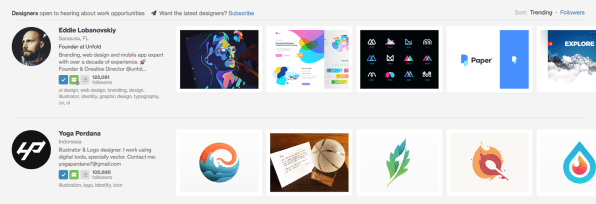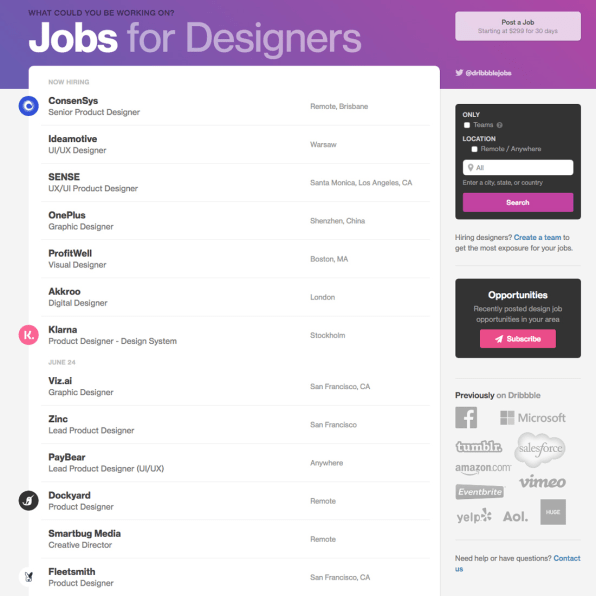Graphic Design Jobs the Today Show Nyc
While 4.5 million designers and professionals use Dribbble, they don't necessarily love using Dribbble. It's intended to be a pool of inspiration and a place for the design community to talk shop, but the platform has faced countless criticisms by the design community–that it's superficial, for example, and doesn't promote real problem solving or idea sharing. It's just a lot of pretty pictures.
Now, in an effort to grow from a small business into a sizable, scalable one, Dribbble is embracing its role as a visual résumé. Led by CEO Zack Onisko–who previously led growth at BranchOut, Hired, and CreativeMarket, the latter of which sold to Autodesk–the company is launching a new service that will charge recruiters and companies to connect with designers through a new suite of services called Dribbble Hiring.
Think of this new Dribbble as less of a Behance competitor and more a LinkedIn competitor, for a world in which design has caught on in Fortune 500 companies but designers themselves are in short supply. Dribbble will be offering a subscription-based search portal, starting at $49 a month and reaching $399, for recruiters to find specific design talent. On top of that, Dribbble is also introducing a white glove service–for an undisclosed price–through which the company will match recruiters with the right designer to fill a job. Say you're a product manager at Google and you need to find an animator–Dribbble might be the place you could easily search for one.

For now, designers aren't charged to be included in talent pools, but Dribbble is testing promoting one's portfolio and monetizing that end of the model, too.
"We've started to see the Facebooks, Dropboxes, and Airbnbs start to acquire design agencies. It's so hard to find designers, it's easier to just drop the cash on whole agencies. It's a massive demand," says Onisko. "If you ask anyone on a design team where you go to hire designers, Dribbble is the first word out of their mouth. It's something people have been doing scrappily . . . Now we're baking in the tools to make those searches smarter."
Dribbble has been around for roughly a decade, but the service has sustained itself as a relatively small business–a rarity in the world of unicorn-or-bust internet companies. Onisko declined to share the company's revenue, but Dribbble is operated with a team of just 33 remote employees, a headcount that Onisko actually quadrupled since joining the company 18 months ago.
"My job as CEO has been to take a small business and evolve it into a scalable company," he says. In turn, he's expanded the company's advertising and premium portfolio subscription models to include a biyearly design conference. The undisclosed revenue is up 200% since he took the position. He's also acquired a few companies, including Crew, a platform for hiring freelance designers.

Dribbble has folded Crew's talent matchmaking algorithms into the Dribbble brand. That's a large part of what Dribbble Hiring is–Crew's functionality is being knit right into Dribbble's website. On top of that, Dribbble is imagining itself as a long-term hiring service that operates between designers and companies, not just a vehicle for one-off jobs.
How does Dribbble know which of its users are interested in recruitment? All members now have the option to toggle their job interest on or off. They can also define their own level of seniority–and salary requirements. This data, coupled with actual portfolios–which might range in specialty from typography to mobile UX–helps Dribbble's search algorithms connect recruiters to the right talent. While Dribbble Hiring is just launching, the company points out that it's helped companies including Apple, Ideo, Slack, Amazon, Netflix, and Lyft all find talent in the past.
Nothing about its plans sound particularly high tech, but it is strategically sound. Onisko believes that Dribbble's recruiting service will quickly outpace the revenue it makes from other other streams. "We really become a matchmaking company at that point," says Onisko. Critics have called Dribbble nothing but a glitzy design portfolio–but ironically, embracing that nature could make the company more successful than ever before.
Graphic Design Jobs the Today Show Nyc
Source: https://www.fastcompany.com/90177053/dribbble-wants-to-find-your-next-design-job
0 Response to "Graphic Design Jobs the Today Show Nyc"
Post a Comment